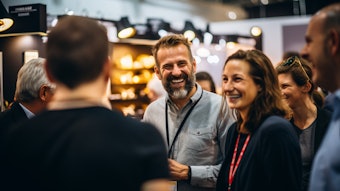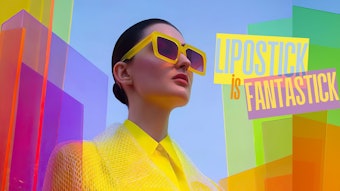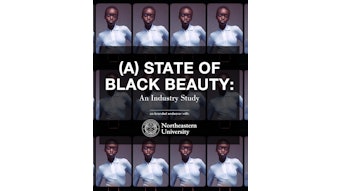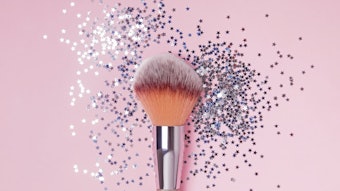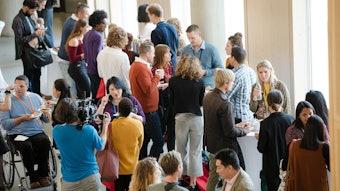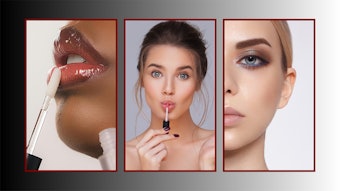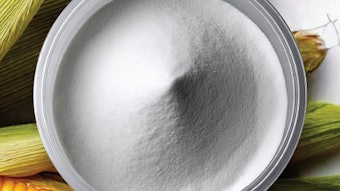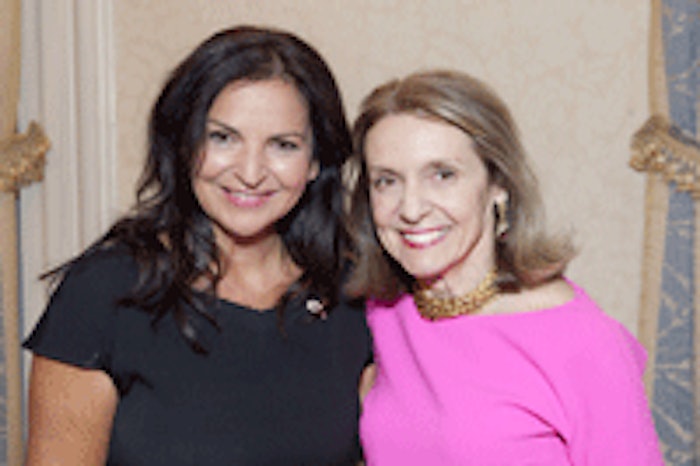
Cosmetic Executive Women (CEW) presented The Estée Lauder Companies' Veronique Gabai-Pinsky at its Women & Men in Beauty Series held October 23, 2013, at New York’s Harmonie Club. The subject of the evening’s discussion focused on the key to building a successful and sustainable fragrance business in today’s market.
While many new fragrances enter the market, others yield flankers, and classics continue to attract and resonate, there is a lot to be said, according to Gabai-Pinsky, for collaborating with iconic names in the fashion world. Jill Scalamandre, CEW chairwoman, lent perspective to the discussion with a leading question, “What do Michael Kors, Tory Birch and Tommy Hilfiger have in common?” The answer, “Veronique Gabai-Pinsky.”
Gabai-Pinsky was named global brand president of The Estée Lauder Companies’ Aramis and Designer Fragrances division in November 2006. She is responsible for the global business of the Aramis, Lab Series Skincare for Men, Coach, Tommy Hilfiger Toiletries, Donna Karan Cosmetics, Michael Kors Beauty and Kiton brands and has recently introduced Ermenegildo Zegna, Marni and Tory Burch to the portfolio as well.
Gabai-Pinsky reports to Fabrizio Freda, president of The Estée Lauder Companies and is a member of the Companies’ executive leadership team. In addition, her responsibilities include BeautyBank and IdeaBank, the entrepreneurial think tank divisions of The Estée Lauder Companies, whose mission is to identify consumer-centric opportunities around the world across product development, channel diversification and regional expansion, to bring these concepts and brands to market through sustainable and profitable business models. Through these roles, Gabai-Pinsky provides a strategic approach to portfolio management, prioritizing long-term planning and brand development, combining creative thinking and business acumen and enhancing relationships with partners and licensors.
A Fragrance Perspective
Moderator Jenny Fine of Beauty Inc began the presentation by noting the answers to a pop quiz, which has become de rigueur for the series. “What fragrance sells one in every eight seconds? Well, that would be, DKNY Be Delicious Apple,” answered Fine, after receiving an overwhelmingly correct response from attendees. The next question dealt with the time it takes to create a scent: which was, 18 months, start to finish. Lending context to the nature of the fragrance business, where fast turnaround and consumer satisfaction are key, the discussion with Gabai-Pinsky began in earnest.
In her response to a question about reimagining the business model for fragrance, taking into consideration the state of the industry since the economic downturn in 2008 and through 2011, Gabai-Pinsky was clear about her commitment to the category. “We had a beautiful fragrance business, and we decided to reassess the model for the beauty prestige world. We were committed to the category but wanted to grow the company, so we needed to do some work in fragrance. As for profitability, we were not as competitive as we could have been,” she explained.
Clearly assessing the image and strategy of the company, Gabai-Pinsky said, “We could have cut costs to get to the profitability that we wanted, but we didn’t want to do that. We wanted to improve the category, the growth margin, and not at the expense of quality or creativity. So, we reshaped the development process. You have to be smart and drive the resources you have by brand and by region, making key drivers as big as they could be."
“We believe in brand building for the long term—we reduced promotions, reinvested in advertising and reinvested in equity building. We built a stronger foundation from which we could build. Again, we wanted fragrance to be an engine of growth for the company. There was a piece of the portfolio that we looked at carefully. We elevated the brand’s equity and added Marni, Zegna and Tory Burch. Strategically, you look at your portfolio and what your properties are, so that they don’t cannibalize one another,” she said.
“Obviously we have a lot of brands coming to us, and we think of several things. For example, what is the level of sales and awareness of the brand today? A brand can be small, but if it has a high growth rate, that is key. Then, we look at the type of consumer, the reaches and the strengths of the brand. Are they super strong in one country, for example? In the context of Zegna, which is a strong brand in China, this allowed us to tap more into the men’s segment, in addition to the Aramis brand. In Europe, we wanted to anchor the European consumer to come to us, as well as the higher end segment consumer,” she explained.
The unique character of a brand is something to be looked at closely. “Each brand is very different from one another. We need to respect the unique identity of each one. We’re not here to transform their equity, but understand them from within, what motivates them, so you understand the emotional platform of the brand. We spent time looking at everything about each brand to extract its core value, its DNA,” she said.
Relationships Are Key
“At the beginning of the relationship, when we are in the process of seeing if we will marry—we don’t date in this process—we try to understand honestly and candidly what the brand expects from the fragrance category and how they want to reach that goal,” Gabai-Pinsky related. Reiterating the importance of complementarity in the relationship, she noted, “You need to have common views about what you want to achieve together. Just like with a marriage, it is absolutely fundamental to see if there’s a fit. If not, it’s better not to go there. Also, we ask them what inspires them, what touches them, how do they come out with a collection.”
When Fine asked, “Once you’ve made it to the altar, how do you resolve conflicts?,” Gabai-Pinsky did not skip a beat. “You have to be very honest," she said. "Big conflicts arise very rarely, but you need to maintain a constant level of communication. I am in touch with each licensee regularly. We don’t wait for a meeting. Small conflicts happen, sometimes in product development and execution. If there is a discussion regarding creativity, we listen. When it comes to performance, we are the experts, and we can help them win in the marketplace."
Regarding Fabrizio Freda, Gabai-Pinsky noted his brilliance as a businessman. “Freda was not an expert in fragrance when he joined the company, and we had a very good conversation,” she explained. “He is brilliant. He looks at the consumer first, [and] is unbelievably savvy when it comes to business and whether it will be profitable. I look at the brand fit. In the end, we come from two different perspectives to create the perfect fit. From the product development end, we go to the craft of the fragrances, the craft of the category. We try to share with him the beauty of the craft, and he showed us the beauty of turning craft into successful business."
Innovation and Execution
Regarding Michael Kors and Tory Burch, Gabai-Pinsky noted that they were “doing great,” adding, “We feel that we have captured the identity of those designers with products that bring their essence to the market.” She described the products as “fabulous, innovative and gorgeous,” noting the effort it takes to bring the products full circle. “We’ve taken a lot of time to execute with patience and diligence to launch the best products for Kors and Tory Burch. There is legitimacy for these brands to be in fragrance and color cosmetics. For Kors, it’s a wardrobe of looks—sporty, glam, sexy—but it’s great to add lip color and shine on the body. That would make a great statement for Kors,” she said. “When you have a story to tell, you need the ability to tell it, which Macy’s has helped us with for the Kors story."
“For Tory, she was very inspired by her parents and originally inspired by her mother’s vanity table and its essential beauty pieces. This is part of her story,” said Gabai-Pinsky.
Growing the fragrance category is clearly a passion for Gabai-Pinsky, who provided a glimpse of what the category numbers have looked like in recent years. “The trend has been for the category to grow about 1%...not very exciting. But, then you have to double click. It’s actually losing 25% of its business every year, so you have to grow with your solid brands and grow above the market. Or, you double click and look at each market, for example Brazil, which is very strong, and then you have to bring fabulous innovation to the market. You might say that the market doesn’t need another red lipstick, but if you bring the most fabulous red lipstick, or fragrance, to the market, and make them as solid as possible to grow year by year, you will have a success. DKNY’s Be Delicious is an example. The first time you buy, you’re interested in the story and the bottle, and then, the juice. With Be Delicious, we did a story that touches people across cultures—that is Adam and Eve, and finding the man of your life. This story is very emotionally driven, and the juice is fabulous,” she said.
“We have a mantra in the business—that is 'recruit, retain and revive'—so we keep advertising levels consistent and keep pulsing product delivery forms that keep the consumer involved. We build a conversation with our consumer through digital platforms, for example people in Russia are talking with people in Mexico about the brands,” she noted.
Partnerships and Retailers
“Honestly, I want partnerships. What can we build to make a brand bigger than life? What will be a win-win for both parties? It’s a treadmill, so once you fall, you hit yourself very hard. So, with retailers, it really needs to be about sustaining. The same answer applies to suppliers,” Gabai-Pinsky explained, and she also related this to working with advertisers. “A former boss of mine in Paris said to me about advertising agencies, ‘There’s not a bad advertising agency. There’s only a bad brief.' So you need to be very clear about what you want and what they can give you so you can achieve it together,” she said.
In going with a quantitative analysis or a gut decision, Gabai-Pinsky gave her point of view. “This is a business about creativity, so you need to accept the level of risk that goes with creativity, and sometimes you need to validate with quantitative research. We use it as a fine tuning of the way we want to go, which is informed by our instinct and our gut,” she explained.
In response to a question about what drives her, as a veteran of this industry, Gabai-Pinsky did not hesitate. “I am passionate. Loving what you do is what makes you get up in the morning. I’m not driven by power or money, nor is it what drives my team. It’s a passion for creativity, for a fragrance that can add beauty to your world, give you confidence, and add an element of beauty and creativity to the lives we touch. It makes me happy to walk down the street and recognize a fragrance that we have created being worn by someone. If I can touch someone with that beauty, I’m happy,” she said.
The evening’s event was sponsored by Shape, Givaudan, 24 Seven Inc., HauteLook, eXperticity, Beauty Inc, WWD, Kaplow Communications, and Digital Therapy. CEW’s Women & Men in Beauty Series events feature leaders in the industry who offer insights into trending beauty topics and provide inspiration for professional growth.

